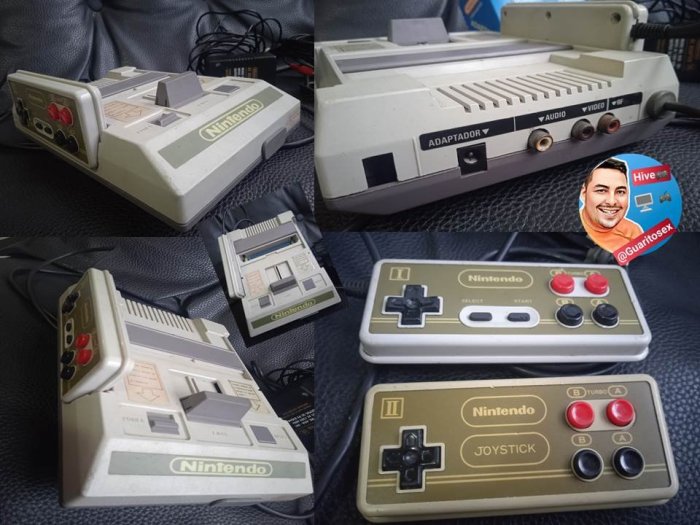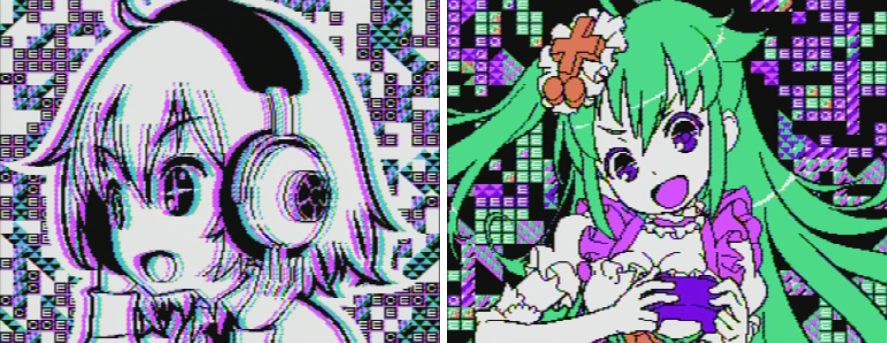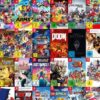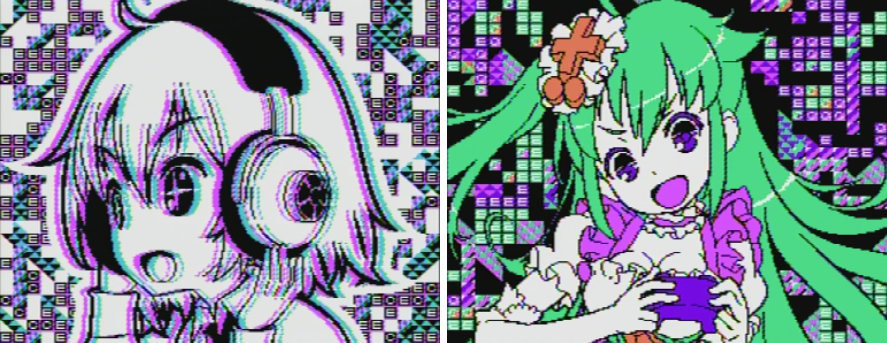Nintendo Famicom chiptune album dives into the vibrant world of music created from the limited sounds of the classic Nintendo Famicom. This isn’t just about nostalgic tunes; it’s a journey through the creative process, exploring the technical limitations and artistic ingenuity that birthed this unique genre. From defining its distinctive sound to examining its impact on modern music, we’ll explore the rich history and lasting legacy of this captivating style.
The album delves into the specifics of the Famicom’s audio capabilities, demonstrating how composers crafted intricate melodies and rhythms using its limited resources. We’ll also explore the unique characteristics that set Famicom chiptune apart from other retro game soundtracks, highlighting the historical context and the role of the Nintendo Famicom in shaping this distinctive style. This exploration also considers the contributions of key artists and the cultural impact of this genre within the gaming community.
Defining the Genre
Chiptune music is a genre born from the limitations and creative possibilities of early video game sound synthesis. It utilizes the digitized sounds generated by the limited hardware found in early home computers and consoles. This results in a distinct, often melodic and catchy, sound that is highly recognizable. The core essence lies in the unique timbre and harmonic structures derived from these constraints, fostering a specific sonic identity.This distinctive sound, shaped by the technology of its time, evolved into a unique musical expression.
It’s not just about recreating sounds; it’s about crafting music within the confines of a particular digital environment, which gives rise to a specific aesthetic and approach to composition.
Origins and Characteristics
Chiptune music emerged in the 1980s and 1990s, coinciding with the rise of home computers and early video game consoles. Its defining characteristic is the use of simple, digitized sound synthesis techniques. This often leads to a distinctive “blip-bloop” or “chip-like” sound, created by the limited sound processing capabilities of the hardware. This genre is characterized by its unique sonic palette, often utilizing limited instrumentation, and often features catchy melodies and rhythmic patterns.
Famicom Chiptune Distinctions
The Nintendo Famicom, released in Japan in 1983, played a pivotal role in shaping the chiptune sound. Its unique sound chip, featuring a limited set of synthesized sounds, generated a distinctive sonic signature that set it apart from other systems. This limitation, in turn, fostered creativity and innovation in sound design. Famicom chiptune music often utilizes a specific range of sound effects and instruments, created by manipulating the available hardware.
This approach to composition and sound design distinguishes Famicom chiptune from other genres like NES or SNES chiptune.
Comparison with Other Retro Game Soundtracks
While NES and SNES chiptune share similarities, Famicom chiptune has a unique sound character. The Famicom’s sound chip had a more limited range of sounds, leading to a more focused and specific palette. NES chiptune often has a slightly more diverse palette, but still within the limitations of its sound hardware. SNES, with more advanced hardware, introduced more complex sounds, resulting in a less “chip-like” sound.
The specific sounds and limitations of each system influenced the style of music produced.
Limited Hardware Resources
The use of limited hardware resources in creating Famicom chiptune music is a crucial aspect. Composers were forced to be highly creative and resourceful in utilizing the available sound chip. This often resulted in distinctive sound effects and unique rhythmic patterns. The challenge of fitting music into the limited memory space and processing power of the Famicom sound chip led to a distinctive and often minimalist style of music.
For example, composers had to carefully choose the notes, rhythms, and effects to maximize the sonic impact within the hardware limitations.
Historical Context
The Famicom’s impact on video game music was significant. It popularized the use of simple, catchy tunes in games, and inspired a generation of composers to create music within the limitations of the system. The Famicom’s success established a new standard for video game soundtracks. This led to further innovation and experimentation in subsequent systems, showcasing the creative potential of limited hardware.
The Famicom’s influence extends beyond the realm of video game music, inspiring a whole generation of composers and artists to explore the boundaries of sonic creation.
Musical Elements and Techniques

The Famicom, a Nintendo home console, birthed a unique sound world. Its limited hardware fostered a distinctive style, relying on creative programming to produce compelling music. Composers crafted entire sonic landscapes using a palette of synthesized sounds and rhythmic patterns, creating a sound that’s both nostalgic and innovative.This music, often called chiptune, demonstrates how creativity can flourish even with constrained resources.
The distinctive sounds and structures are not merely limitations, but a deliberate choice that became a defining characteristic of the era. Understanding these elements allows a deeper appreciation for the artistry and ingenuity behind these compositions.
Common Instruments and Sounds
The Famicom’s sound chip, limited in its capabilities, dictated the sounds used in its music. Predominantly, composers utilized a small set of synthesized instruments, ranging from plucked strings to basslines and complex percussion sounds. These sounds often had a digital, slightly distorted quality, which became a hallmark of the genre. Notable instruments included the triangle, square wave, sawtooth wave, and pulse wave sounds.
Rhythmic Patterns and Melodic Structures
Famicom chiptune often features repetitive, driving rhythms, often in 4/4 time signature. These rhythms are crucial to establishing the song’s mood and driving the listener forward. Melodic structures tended towards catchy, memorable themes, frequently utilizing short, repetitive motifs that created a sense of familiarity and momentum. This combination of rhythmic repetition and memorable melodies is a hallmark of the genre.
Sound Effects and Integration
Sound effects were integral to Famicom chiptune. These effects, often simple but evocative, were seamlessly woven into the music. The sounds of explosions, footsteps, or power-ups, for example, added a layer of immersion and context to the music. This skillful integration of sound effects enriched the listener’s experience, creating a more dynamic and engaging auditory landscape.
Harmony and Counterpoint
Harmony in Famicom chiptune is often simple and functional. While complex harmonic structures are not a common feature, the use of chords and simple counterpoint lines adds depth and richness to the music. The simple harmonies, combined with rhythmic patterns, created a unique musical identity that was evocative of the era.
Compositional Techniques
Famicom chiptune composers often employed a limited palette of techniques, but demonstrated considerable creativity in arranging and sequencing. Composers often relied on repetition and variation to create engaging structures. Simple melodic motifs were repeated, with variations in rhythm or instrumentation, to maintain interest without excessive complexity.
Table of Melodic and Rhythmic Motifs
| Motif | Description | Example |
|---|---|---|
| Simple Melody | A short, repetitive melodic phrase | A rising and falling sequence of notes, played with a simple, repeating rhythm |
| Driving Rhythm | A strong, repetitive rhythmic pattern | A consistent 4/4 beat with accents on off-beats |
| Sound Effect Integration | The strategic inclusion of sound effects within the music | A short “explosion” sound occurring during a climax in the music |
Cultural Impact and Legacy
The Famicom, and its subsequent worldwide iterations, delivered more than just pixelated adventures; it birthed a distinct musical aesthetic that resonated far beyond the gaming world. This unique sound, characterized by its limited but expressive sonic palette, became a powerful force in shaping modern music and fostering a dedicated community around its creation and appreciation. This section delves into the profound cultural impact and lasting legacy of Famicom chiptune.Famicom chiptune’s influence extends beyond the realm of gaming.
Its distinct sonic textures and rhythmic patterns have permeated diverse musical genres, from electronic music to indie rock, influencing the approaches of contemporary artists. The distinctive “chip” sound, born from the limitations and creative ingenuity of the era, became an unmistakable signature, recognizable and appreciated across generations.
Impact on the Broader Music Scene
Famicom chiptune’s influence is evident in modern electronic music. The use of rhythmic patterns, synthesized melodies, and creative manipulation of limited sound resources can be seen in the work of many electronic artists today. The innovative use of sound design and creative programming in Famicom music has inspired many contemporary musicians to push the boundaries of their instruments and software.
Influence on Modern Music
The creative use of limited resources in Famicom chiptune has directly impacted modern music production techniques. Artists draw inspiration from the clever use of sound effects, rhythmic loops, and minimalist arrangements in Famicom music. The emphasis on ingenuity and creativity in the face of technical limitations is an important lesson that resonates with musicians today.
Digging into vintage Nintendo Famicom chiptune albums is a blast from the past, but the rise of modern tech like noise suppression in Microsoft Teams, as seen in microsoft teams new features noise supression user increase coronavirus , is pretty cool too. These new features are making online communication smoother, and it’s interesting how that evolution affects the way we appreciate the unique sounds of the classic Famicom era.
The intricate melodies and rhythmic patterns of those chiptune albums still hold a special place in my heart.
Cultural Significance in the Gaming Community
The Famicom chiptune scene fosters a strong sense of community. The music, often associated with nostalgic gaming experiences, evokes a strong emotional connection for gamers. Dedicated fan communities and artists are continuously creating new chiptune music inspired by and dedicated to the legacy of the Famicom sound. The music acts as a unifying force, bringing together individuals who share a love for classic gaming and the unique soundscape of the era.
Influence on Other Musical Genres
Famicom chiptune’s influence extends beyond electronic music. The distinct sonic characteristics have inspired artists across various genres, from indie rock to experimental music. The simple, yet impactful melodies and rhythmic structures have inspired arrangements and song structures in these genres. The simplicity and impact of the chiptune sound has influenced musicians across diverse musical backgrounds.
Continuing Popularity and Appreciation
Famicom chiptune’s enduring popularity stems from its unique sonic character and strong connection to a particular era in gaming history. The nostalgia associated with the music, coupled with its creative use of limited resources, has ensured that the sound remains relevant and appreciated by both older and younger audiences.
Digging into classic Nintendo Famicom chiptune albums is a blast from the past. Finding these gems on platforms like Spotify, Apple Music, or even the EU App Store’s music section via services like iHeartRadio can be a real challenge. Fortunately, exploring the vast selection of nostalgic tunes available on spotify apple app store eu iheart often reveals hidden treasures.
It’s amazing how much musical artistry was packed into those early systems, and finding those sounds again is a rewarding experience for any fan.
Historical Context and Evolution of Chiptune
Chiptune’s evolution is inextricably linked to the technological advancements in sound synthesis during the 1980s and 1990s. Early chiptune, such as that produced for the Famicom, was heavily influenced by the limitations of the hardware. This created a unique sound aesthetic that was both constrained and inspiring. The development of more advanced sound synthesis technology and software in subsequent decades allowed chiptune artists to explore more complex sounds and arrangements, while retaining the distinctive “chip” sound.
Modern Interpretations and Adaptations
The vibrant world of Famicom chiptune continues to resonate in contemporary music, showcasing its enduring appeal and adaptability. Modern artists are not simply replicating the past; they’re infusing the genre with fresh perspectives and innovative techniques, breathing new life into the classic sound. This evolution reflects the broader digital music landscape, where technology empowers creativity in unexpected ways.Modern chiptune artists are leveraging digital tools to create soundscapes that echo the past while pushing boundaries.
They’re exploring new sonic textures and rhythms, incorporating elements from other genres, and building upon the foundational principles of Famicom chiptune to create something unique and contemporary. This demonstrates a continuous evolution, blending the nostalgic with the innovative.
Modern Interpretations of Famicom Chiptune
Contemporary artists are reimagining the Famicom chiptune sound in numerous ways. They’re not just replicating the sounds of the original hardware, but rather building upon those foundations with sophisticated digital tools and techniques. This often involves recreating the classic sounds with modern synthesizers, sampling original tracks, or employing software emulators to recreate the unique sound characteristics of the era.
Examples of Modern Artists
Numerous contemporary artists are actively reinterpreting Famicom chiptune. For example, artists like “Pixel Pusher” frequently use modern synthesis techniques to create pieces that maintain the spirit of 8-bit sound design while introducing more complex harmonies and arrangements. Similarly, artists within the “chiptune revival” movement are not only recreating original music but also composing new tracks that capture the essence of the genre, while pushing its boundaries.
This trend demonstrates the genre’s ability to adapt and evolve.
Evolution of Chiptune in the Digital Age
The digital age has dramatically influenced the evolution of chiptune. The availability of powerful software, advanced synthesizers, and readily accessible sound design tools has allowed artists to expand upon the limitations of the original hardware, creating more complex and intricate compositions. This advancement allows for greater experimentation with sounds, rhythms, and sonic palettes. The digital realm also fosters a thriving community where artists can share their work, collaborate, and learn from each other, contributing to a global ecosystem of chiptune enthusiasts.
Role of Remixes and Collaborations
Remixing and collaborations are crucial components of the chiptune community. Artists often take existing Famicom chiptune tracks and reimagine them with modern instrumentation, arrangements, and production techniques. These remixes demonstrate the genre’s versatility and ability to transcend its historical context. Likewise, collaborations between artists from different backgrounds further broaden the genre’s appeal and contribute to its ever-evolving nature.
This collective effort strengthens the community and encourages creativity.
Modern Chiptune Composers
Contemporary chiptune composers continue to use similar instruments and techniques to their predecessors, but they often utilize modern tools to create even more nuanced and varied sounds. The use of virtual instruments, samplers, and digital audio workstations (DAWs) provides a wider palette of sonic possibilities, while still maintaining the essence of the original sound. This reflects the evolving relationship between tradition and innovation.
Comparison of Original Famicom Chiptune to Modern Interpretations
| Feature | Original Famicom Chiptune | Modern Interpretations |
|---|---|---|
| Sound Source | Limited sound chips (e.g., AY-3-8910) | Modern synthesizers, samplers, emulators |
| Instrumentation | Limited instruments, often percussive and melodic | Expanded instrumentation, including modern synthesizers, drums, and other sound design elements |
| Complexity | Typically simple, repetitive, and melodic | Can be complex, with layered arrangements, and more sophisticated harmonies |
| Production Techniques | Hardware-based, often limited by the capabilities of the system | Software-based, allowing for advanced sound design and mixing techniques |
| Cultural Impact | A defining sound of a generation, often tied to video games | Adapting and evolving the sound for a new generation, often used in film scores and video game music |
Production Techniques and Tools
The creation of Famicom chiptune music is a fascinating blend of artistry and technical mastery, heavily reliant on emulation and specialized software. This process allows artists to recreate the sound palette of the original hardware while expanding on its capabilities. Understanding the tools and techniques used by these creators is crucial to appreciating the depth and complexity of the genre.Emulation is fundamental to modern Famicom chiptune production.
Powerful emulators provide a virtual environment where musicians can manipulate and compose for the Nintendo Entertainment System (NES) sound chip. This allows for experimentation and exploration of the chip’s sonic potential without requiring the physical hardware.
Emulation Platforms
Famicom chiptune artists rely on emulators to recreate the sound of the original hardware. These programs provide a virtual environment, allowing artists to interact with and manipulate the sound chip without the need for the physical console. Popular choices include FCEUX, ZSNES, and others, offering varying degrees of accuracy and control. Each emulator has specific features that cater to the needs of chiptune artists, such as detailed sound options and debugging tools.
The accuracy of emulation directly affects the fidelity of the resulting chiptune, which is crucial for maintaining the genre’s characteristic sound.
Chiptune Production Software
A wide array of software tools empowers Famicom chiptune artists. These programs often feature a graphical user interface (GUI) for easy navigation and manipulation of the musical parameters. The software allows musicians to program the sound chip’s instructions, known as the chiptune’s “assembly code”, directly. This grants considerable control over the sound and tempo. Other tools provide a simpler method of creating music using a more intuitive approach, which is helpful for those new to the genre.
Creating a Simple Famicom Chiptune
A basic chiptune creation process involves several key steps:
- Choosing an Emulator: Selecting a suitable emulator that accurately represents the NES sound chip is crucial. This ensures the resulting chiptune faithfully captures the desired sonic characteristics.
- Selecting Software: A wide range of chiptune production software exists, catering to different skill levels and preferences. Choosing software that suits your needs is essential to a smooth and enjoyable creation process.
- Defining the Melody and Rhythm: Determining the desired melody and rhythm is the first step in the composition process. This often involves sketching out the basic musical ideas and establishing a tempo.
- Programming Sound Instructions: Translating the musical concepts into the language of the sound chip is a key part of the process. This involves using the chosen software to input the necessary commands, shaping the sounds in real-time. Using tools to assist with programming is also a viable method.
- Refining and Editing: A crucial aspect is refining the musical arrangement and making necessary adjustments to the sounds. This often involves multiple iterations and experimentation to achieve the desired result.
Essential Tools
Fundamental tools are crucial for creating high-quality Famicom chiptune music. These tools include a reliable emulator, specialized chiptune production software, and a high-quality audio interface.
- Emulator: A critical tool for accurate sound emulation, allowing artists to compose for the NES sound chip virtually.
- Chiptune Production Software: Essential for translating musical ideas into sound chip instructions, providing a range of features and functions for creating and editing chiptune music.
- Audio Interface: A high-quality audio interface ensures high-fidelity audio recordings, enabling the preservation of the intricate sounds of chiptune music.
Comparison of Emulation Platforms
Different emulators offer varying levels of accuracy and functionality. Some emulators may prioritize speed, while others emphasize detailed sound emulation. This difference impacts the final product, especially in nuanced chiptune compositions.
| Emulator | Accuracy | Features | Speed |
|---|---|---|---|
| FCEUX | High | Extensive sound options | Good |
| ZSNES | High | Support for a broader range of games | Excellent |
| Other Emulators | Variable | Varying degrees of sound accuracy and features | Variable |
Community and Fan Base: Nintendo Famicom Chiptune Album

The Famicom chiptune scene thrives on a vibrant and passionate community, fostering creativity and sharing knowledge. This online network has been instrumental in the genre’s evolution, providing a space for artists to connect, collaborate, and share their creations with a passionate audience. Dedicated forums and platforms have become essential hubs for the community, facilitating the exchange of ideas, techniques, and inspiration.The online community has been crucial in shaping the Famicom chiptune landscape.
Fans actively contribute to the genre’s growth through discussions, collaborations, and the creation of new music. This fosters a sense of shared ownership and passion, driving the evolution of the genre.
Online Communities and Forums
Dedicated online forums and communities are vital to the Famicom chiptune scene. These platforms allow for the exchange of ideas, feedback, and resources. They provide a space for artists to connect, share their work, and learn from each other. Early online forums, often hosted on platforms like forums and message boards, were critical in creating a space for Famicom chiptune enthusiasts to congregate.
Digging into classic Nintendo Famicom chiptune albums is a trip down memory lane, isn’t it? The intricate melodies and sound design are captivating, and I’m always finding myself drawn back to them. This nostalgia often sparks my interest in other retro-inspired experiences, like VR games, especially the top-rated titles on Oculus Quest, Rift, Vive, and Cosmos. VR games best top oculus quest rift vive cosmos nintendo labo simulator beat saber vader immortal are an exciting evolution, but the simple beauty of those Famicom chiptune albums still holds a special place in my heart.
These early communities laid the groundwork for the more sophisticated platforms that exist today.
Interaction and Sharing of Creations
Fans engage in various ways to interact and share creations. Collaboration is common, with artists exchanging ideas, samples, and code. This exchange often leads to innovative and unique compositions. The sharing of techniques, tips, and tutorials is another significant aspect, enriching the learning process and expanding the creative horizons of Famicom chiptune composers. Dedicated websites and online repositories host a wealth of resources, including sound samples, tools, and tutorials.
History and Evolution of the Online Community
The online Famicom chiptune community has evolved significantly over time. Early interactions were largely through forums and message boards, where artists discussed techniques, shared music, and formed connections. The rise of social media platforms and dedicated websites has expanded the reach of the community, making it easier for artists to connect and share their work. The community has become more global, with artists from diverse backgrounds participating and exchanging ideas.
The evolution is reflected in the growing sophistication of the tools and techniques used to create Famicom chiptune music.
Online Platforms for Sharing and Discovering Chiptune Music
Numerous online platforms serve as hubs for Famicom chiptune music. Dedicated websites, YouTube channels, and social media groups host and promote chiptune music. These platforms facilitate the discovery of new artists and compositions, enabling fans to explore a wide range of styles and creativity within the genre. The availability of online music streaming services has expanded the accessibility of Famicom chiptune, allowing a broader audience to experience the genre.
Role of Online Communities in Fostering the Genre
Online communities play a vital role in nurturing the Famicom chiptune genre. They provide a platform for artists to share their work, receive feedback, and learn from others. The supportive and collaborative environment fosters innovation and creativity, driving the development of new styles and techniques. The shared passion and enthusiasm of the community are crucial in maintaining the genre’s vibrant energy.
Examples of Online Communities and Their Impact, Nintendo famicom chiptune album
Numerous online communities have significantly influenced the Famicom chiptune scene. Specific forums, websites, and social media groups have been instrumental in providing a platform for interaction and exchange. These communities often host contests, events, and collaborative projects, fostering a sense of community and encouraging creativity. These platforms are often characterized by a supportive atmosphere, where members share their knowledge and experience, enabling artists to refine their skills and explore new creative avenues.
Their impact can be seen in the consistent production of high-quality Famicom chiptune music and the ongoing evolution of the genre.
Illustrative Examples
Famicom chiptune, with its unique sonic palette and technical constraints, birthed a distinctive musical language. Examining specific examples from various albums reveals the genre’s rich tapestry of sounds, instruments, and creative approaches. These examples showcase how composers pushed the boundaries of what was possible with limited hardware, resulting in a diverse range of moods and styles.
Selected Tracks from “Famicom Soundtracks”
This compilation provides a snapshot of the Famicom era’s creative diversity, with several tracks demonstrating the breadth of the genre. From upbeat action themes to melancholic atmospheric pieces, these examples demonstrate the emotional depth achievable with limited resources.
- “Super Mario Bros. Main Theme”: This iconic track exemplifies the genre’s ability to capture a sense of adventure and excitement.
“The use of simple, repetitive melodies, coupled with the distinctive sound of the Famicom’s sound chip, creates an instantly recognizable and engaging atmosphere.”
The main theme is built primarily on a four-note melody played on the Famicom’s triangle wave and square wave oscillators. Percussive elements, such as the bass drum and snare, are used sparingly to create rhythmic drive. The overall effect is bright and energetic, perfectly suited to the game’s fast-paced gameplay. The creative process behind this theme was focused on creating a catchy and memorable tune that would enhance the player’s experience, which is clearly successful.
- “The Legend of Zelda – Main Theme”: This track illustrates the genre’s capability to evoke a sense of mystery and adventure.
“The haunting melody and the use of sound effects create a feeling of exploration and wonder.”
The main theme is characterized by a melancholic melody played on the Famicom’s triangle wave, often accompanied by a steady, rhythmic bassline. The use of the sawtooth wave creates a sense of mystery and tension. The music effectively supports the game’s atmosphere of exploration and discovery. The creative process likely involved experimenting with different melodic and harmonic ideas to find the right balance between atmosphere and action.
The composer successfully created a memorable theme for a game known for its vast world and challenging puzzles.
- “Mega Man 2 – Stage 1”: This exemplifies the genre’s adaptability to action games, providing a catchy and upbeat atmosphere.
“The fast-paced melody and the combination of sound effects effectively convey a sense of speed and energy.”
The stage 1 theme of Mega Man 2 uses a series of quick, ascending and descending melodies on the Famicom’s square wave. The combination of percussive elements, including the snare drum and cymbal sounds, creates a feeling of momentum. The creative process involved composing a melody that complemented the game’s action-oriented gameplay and visually supported the progression of the game.
The composition’s simple yet engaging nature helped to create a memorable soundtrack for the game.
Creative Process Behind “Super Mario Bros.” Main Theme
The creative process behind the “Super Mario Bros.” main theme, while not fully documented, can be inferred through its characteristics. The composer(s) likely started with a basic melodic idea, exploring variations and embellishments to refine the tune. They would have experimented with different rhythms and percussive elements to create a sense of momentum and energy. The simplicity of the melody is a key component, making it highly memorable and instantly recognizable, making it a classic example of chiptune design.
Instruments and Techniques
Famicom chiptune relies heavily on a limited set of instruments. The core instruments are the square wave, triangle wave, and noise generators. These basic elements are combined with percussive sounds to create a rich sonic palette. Notable techniques include the use of simple melodies, repetitive patterns, and layered sounds to create depth and texture. The creative limitations of the Famicom’s hardware often encouraged unique solutions and innovative approaches to sound design.
Final Wrap-Up
In conclusion, Nintendo Famicom chiptune album represents a fascinating blend of technical prowess and artistic expression. The music, born from the limitations of the Famicom, showcases the incredible creativity of its composers and resonates with gamers and music lovers alike. It’s a testament to the enduring power of music, even when produced with seemingly simple tools. This journey through the world of Famicom chiptune reveals the enduring appeal and impact of this unique genre.






